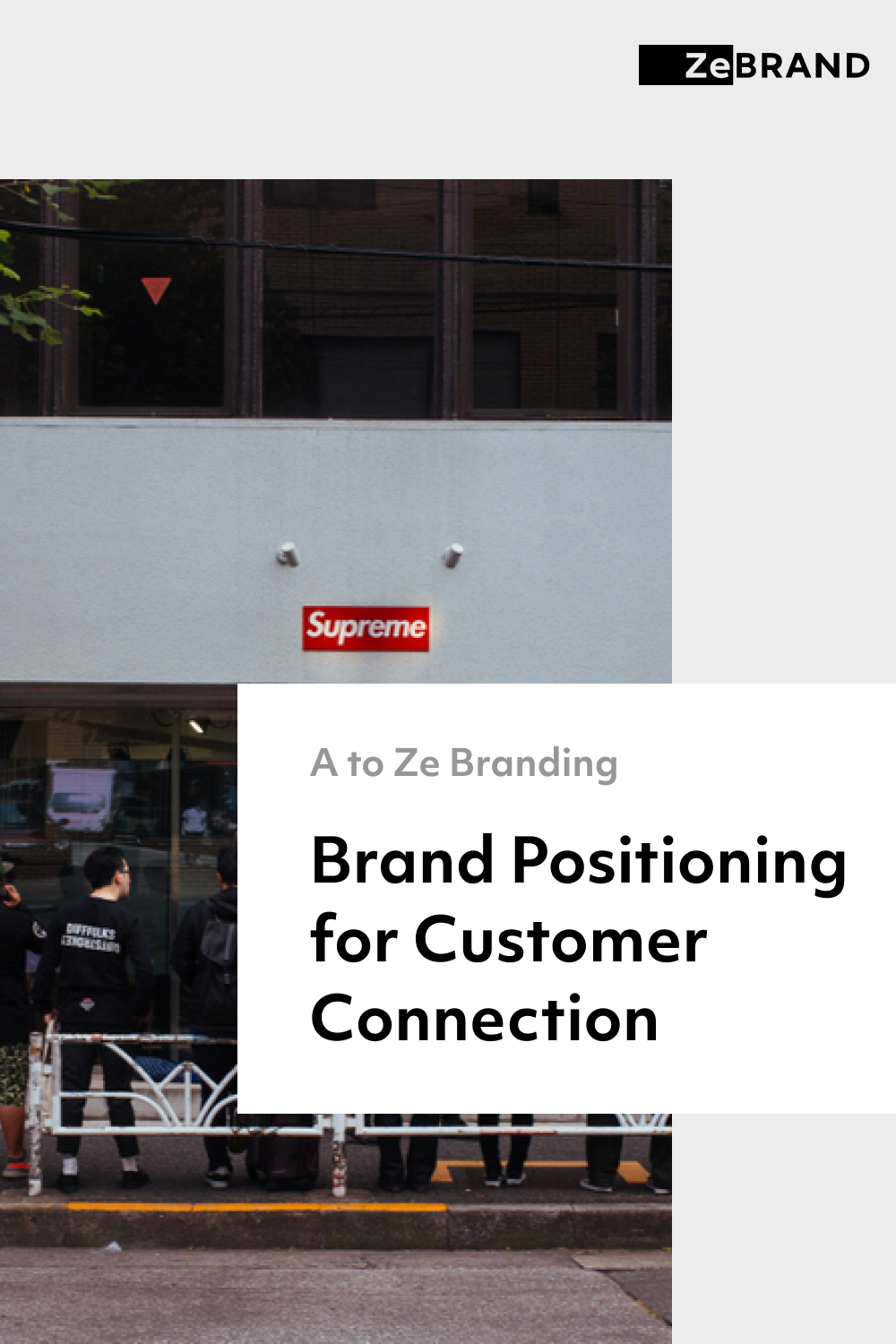Brand Positioning for Customer Connection

Supreme has successfully positioned itself as the go-to hype streetwear brand among young consumers, and even gaining a cult fan following.
At ZeBrand, we believe your vision deserves to be seen and realized. In this content series, we help you use brand as a tool to power up your business and jumpstart your growth.
Welcome to Part 5 of A to Ze of Brand Building -- 'Brand Positioning for Customer Connection'. (Read Part 4 here if you missed it!)

Photo by Melanie Pongratz on Unsplash
At first attempt, shaping a brand identity can be an overwhelming task.
The possibilities are endless, and it can seem easy to make decisions based on purely subjective preferences: Some people like red, some like blue. Some in your team may believe it’s best to “play it safe”—to settle on a brand look that’s in line with industry expectations. Others may believe it’s better to disrupt the status quo—to make a statement with something more daring.
This is a dilemma that even the biggest brands face in due course. As our habits and lifestyles change along with ever-evolving technology and shifting cultural norms, brands must redirect themselves to keep up with consumer interest. Suddenly, companies are breaking away from tradition and defying expectations: Insurance companies like Lemonade are going mobile-first and boasting playful illustrations with bright pink overtones. High-fashion brands like Louis Vuitton and Gucci are channeling more and more of a casual streetwear look. Casper has proven that even mattress shopping can be fun and exciting.
So how do you figure out the best way to position your brand in the current market landscape? How do you cut through subjectivity and make the right choices for your company?
Thankfully, there’s a science behind it all.
‘Brand Positioning’ refers to how someone perceives your brand in relation to your competitors, industry, and—most importantly—their daily lives. The positioning of your brand makes clear what it has to offer and why consumers should choose your brand over an alternative. You could develop a positioning for your brand as a whole, or for individual products. Sometimes it can appeal to potential customers by making them aware of a problem they never knew they had.
Figuring out the best positioning for your brand can feel like guesswork at first, but at its core are three simple steps to keep you on track:
Step 1: Distill Your Brand’s Unique Value
Whether something is valuable or not is ultimately up to the customer to decide. But in order to help them realize your brand’s value, you must identify and amplify what is uniquely distinct about your brand and offering. The ideal positioning is composed of three ingredients:
Ingredient One: A Company's Origins
When it comes to brand DNA, no two companies are identical. Because of their histories, capabilities, and past experiences, all companies have unique origin stories to draw from. For instance, Tesla is known as a pioneer for visionary thinking, has a history of defying expectations, and was birthed by a founder who possesses boundless imagination and drive. No matter what Tesla does or creates, it will always have this halo over it.
Ingredient Two: Distinctive Product Attributes
The product and service offerings of a brand also have their own unique features and benefits. When Tesla released Cybertruck, it boasted its powerful towing capacity and Blade Runner-esque design — both of which align with the brand’s reputation for mixing function and fantasy.
Ingredient Three: Customer Characteristics
To position your brand effectively, it’s important that your brand and product attributes align with customer expectations, or that you identify a target group you can readily serve with existing strengths. Cybertruck, for instance, is less about practical performance than it is about hi-tech design. This suggests that rather than targeting contractors and truckers, their audience is more niche, in the urban professionals realm or tech fanatics.
Mixing it all together
So how might you put this information together for your brand positioning? Here is an example based on a real product brief for Google Chromebook:
Schools all over the world are making commitments to improving students’ digital literacy. They need durable products to purchase in mass that require low maintenance. Google has decided to address this need and create a brand for a computer that can serve this market.
Google is known for broadening the world’s access to information as well as powering Google Chrome, an easy-to-use internet browser with a broad range of plug-ins (company origins). More recently, it has also found a way to build Chrome into a full operating system that allows computers to boot up in a matter of seconds and package it into low cost hardware (distinctive product attributes). You always need to be connected to the internet to use it. But that's no problem for schools and for that matter, many everyday people who are almost always online (customer characteristics).
All of this information can be distilled into a defensible positioning statement that only the Google Chromebook can own:
An instant portal to a world of knowledge available to all students.
When you create your positioning statement, keep it succinct and practical: who is this for, what solution do you offer, and why it is distinctive to anything else that a customer might use. Your positioning statement will be the one sentence response to all three of these questions.

Photo by Charles Deluvio on Unsplash
Step 2: Understand the Codes That Your Industry Uses to Communicate
Within any industry are cues and symbols that reflect what customers have traditionally valued and looked for when choosing products and services of that category. It's essential that you identify these customer expectations by conducting an industry audit. This audit will help inform how your brand addresses your target audience needs.
If you’re creating a new banking app for example, have a look at the visual and verbal language of the finance industry in general. Look at the logos, colors, and imagery of retail banks, investment firms, insurance companies, and payment apps. Once you identify the commonalities, what you’ll have are the ‘codes’ of the industry. For finance, this could be pleasant imagery of families on vacation evoking a worry-free life, or commonly used words like ‘control’ and ‘confidence’ that assure customers of being in good financial hands.
Step 3: Choose to Either Harness the Codes, Break Them, Or Borrow From Another Category
Once you have an understanding of your industry codes, you can now strategically decide which ones reinforce your brand positioning and which don’t. You may realize that you’re serving a market that is set in their ways and therefore it’s more important to harness the industry codes—to be recognized as a formidable competitor rather than a new challenger. In adhering to the codes of your industry, you may choose to use similar imagery, colors and language to evoke familiarity and trust. Or, conversely, if you are targeting youth who are tired and skeptical of traditional financial organizations, you may need to break the industry codes to truly make a splash.
There’s also one more option, which is borrowing cues from another category. Because of the pace of innovation, consumers’ expectations are standardizing across categories. Users may want the same degree of instant gratification that they get from Netflix from their banking app. Or the same level of convenience they get from Uber Eats from a pharmaceutical company. Think about how you can take codes and associations from other industries to give your brand a new point of difference.
We live in a market landscape today that is branding’s most interesting era thus far. Rules are being changed and broken every day. So in this complex world of signs and symbols, how do you find your way? Remember to distill your unique value, understand the codes of your industry, and decide which ones to harness or break. Then make it all visible in your brand identity design, which is precisely where we turn our attention to in our next article -- how to visualize your vision.

A to Ze of Brand Building is a 10-part series about all things branding, with an eye to using branding to engage your customers and grow your business. Continue on to Part 6: The Beginnings of Visual Identity.


